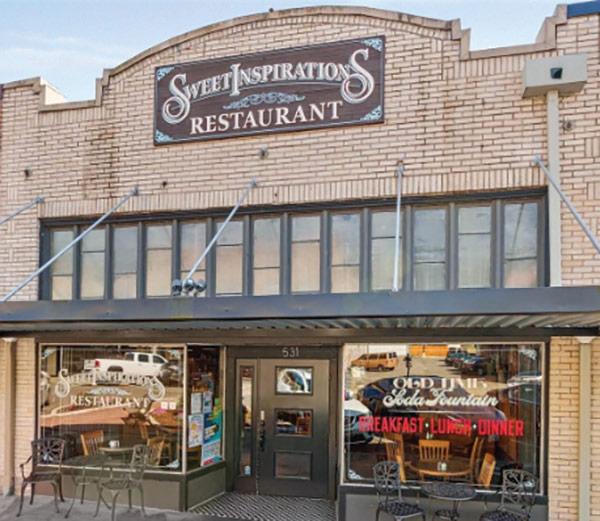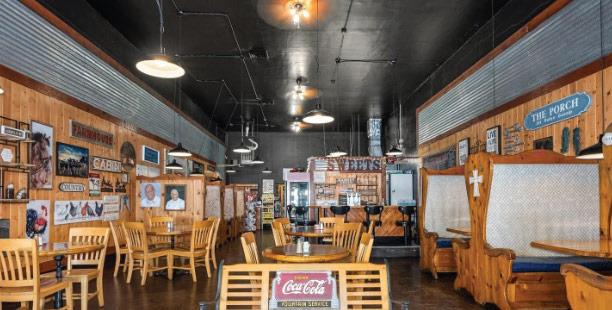Remembering Buck Hubbert
‘A Remarkable Man’ Left a Lasting Legacy in Lewis County
By The Economic Alliance of Lewis County
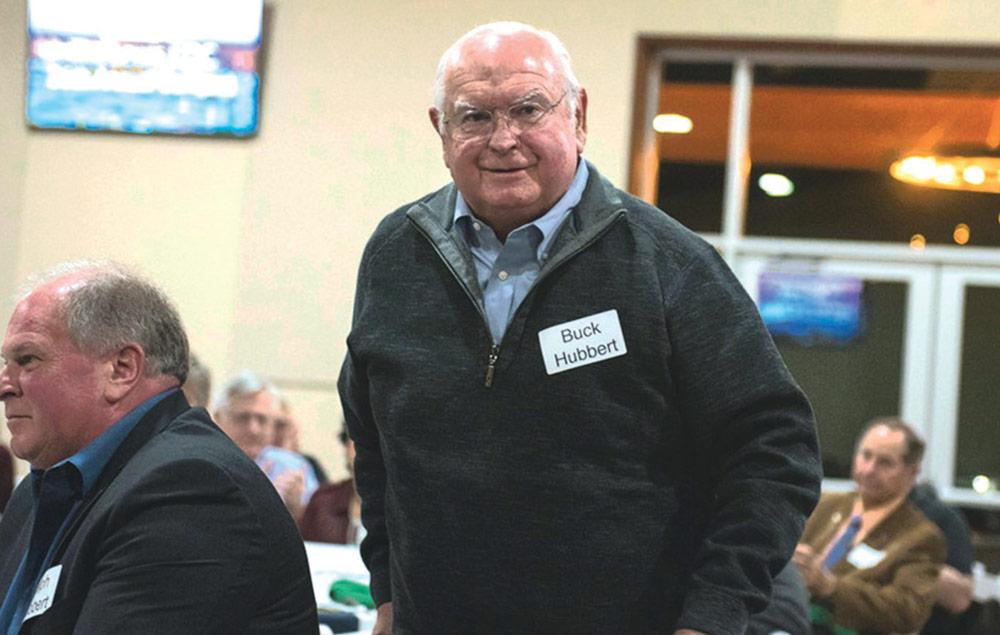
The Chronicle
Buck Hubbert stands up to present the Gail and Carolyn Shaw Industry Award at the Lewis EDC annual banquet a few years ago in this Chronicle file photograph.
Buck Hubbert was a mountain of a man, responsible for decades as a business leader in the community, a fierce fighter for Lewis County economics and a gentle giant at times with an easy smile and welcoming manner.
Charles Allen “Buck” Hubbert was born on Nov. 27, 1943 and passed peacefully Dec. 6, 2023. Born in Tacoma to parents John and Margorie Hubbert. He was an Eagle Scout and graduate from Olympia high school, class of 1962, according to his obituary.
He has been a resident of Chehalis, Washington for over 60 years. He started working at Tires Inc. in 1962 and purchased the business in 1969 with his business partner Bill McWilliams. He took full ownership in 1985 where the business remained in the Hubbert family until 2019.
Buck believed it was important to give back to the community. He was a previous president of the Economic Development Council and a chairman on the Industrial Commission, as well as served 25 years as a board member at Security State Bank.
Over the course of Buck’s life, he was recognized for his commitment to the community and local philanthropy. He was the first recipient of the EDC Gail and Carolyn Shaw Industry award in 2008 and he received the Outstanding Eagle Scout Award in 2016.
Buck was a world traveler, having visited over 30 countries, and an avid hunter including his greatest hunting achievement being the North American grand slam.
He’s earned a lifetime of achievements, accolades, and awards but if asked, Buck would say he was most proud of his family. Buck is survived by his wife of 36 years Kaye Hubbert, son Ralph and Rogette Hubbert, Ralph’s mom Sandy Hubbert, stepson Will Prince, granddaughter Amanda and Matt Ellis, grandson Jonathan and Maggi Hubbert, and great-granddaughter Hudson Hubbert, his sister Sue and Larry Watilo and their family. He was preceded in death by his parents John and Marjorie Hubbert.
Friends Weigh In
Kyle Markstrom, a Port of Chehalis commissioner, said, “Buck Hubbert was the example of how a man should serve his church, family, friends and community. His contributions to our community cannot be measured. I had the honor of calling Buck a mentor and will miss his guiding advice.”
Local businessman Brian James Kopa said, “I was lucky enough to get to know Buck. He is by far one of the nicest, kindest businessmen that I’ve ever met. He will be greatly missed.”
Chehalis City Councilor Daryl Lund said, “So sorry for the loss of Buck. But he was a very great man and made a huge positive difference in our community helping bring in good paying jobs as chairman of the Chehalis Industrial Commission and providing good paying jobs at his Tires Inc. RIP old friend you will always be remembered in our hearts.”
Chris Judd with the United Way of Lewis County, said, “What an enormous loss for our community. Buck was a legend.”
Former long-time director of the United Way Debbie Campbell said, “So sad to hear of the passing of Buck. He was a devoted family man and steadfast community leader. In my dealings with Buck through United Way of Lewis County, I always found him to have a great sense of humor along with his unparalleled empathy, always being there for others. May the family find comfort and strength in cherished memories and the enduring legacy of a remarkable man.”
The ChehalisIndustrial Commission
Buck was a large presence in the Chehalis Industrial Commission, a group that helped form the Economic Alliance of Lewis County (then called the Lewis Economic Development Council — LEDC) back in the 1980s.
The Chehalis Industrial Commission was created by a group of Chehalis-based business leaders in the 1950s in an effort to attract decent-paying jobs to the area. The group sold stock at $50 per share and raised an initial $50,000. A second stock offering in 1957 raised another $50,000, giving the Commission enough to purchase 135 acres just south of Chehalis. From there the Commission continued to grow and attract businesses, but needed a marketing arm to help spread the news that Chehalis was open and ready.
That’s where the Lewis Economic Development Council entered the picture. Encouraged by the Chehalis Industrial Commision, the LEDC formed in 1983 to “encourage business and industrial growth throughout the county,” according to the book “A history of the Chehalis Industrial Commission: A Community-Owned Not-For-Profit (501c3) Group of Friends!” written by local Toledo author Julie McDonald Zander.
For the first decade, the LEDC worked with more than 80 companies to locate in Chehalis, bringing in about 2,300 jobs. The LEDC also assisted in the expansion during that first decade of more than 300 businesses. By 1969 the Chehalis Industrial Commission had attracted industries employing 557 people with an annual payroll of $4 million.
Buck, the former owner of Tires, Inc. in Chehalis, was appointed president of the Commission in 1994, and served as chair into the 2020s.
“We originally bought land and built buildings to bring people to town with good wages,” Buck said in an interview with the Economic Alliance in 2021. “And it hasn’t changed.”
Buck said in the interview the LEDC was formed in part as a marketing arm for the Commission. Buck said the Commission can be “picky” with the businesses it shakes hands with.
“We don’t want a chicken farm in the middle of the port,” Buck said, for example. “We don’t sell our land cheaply or to people who can’t take care of it and they must provide good jobs.”
Buck left a lasting legacy for Lewis County.
2023 Regional Economic Forecast & Innovation Expo
Five Economic Leaders from Thurston, Lewis, Mason, Grays Harbor and Pacific Counties — Gather for Summit
By Joanna Kresge
South Sound Business – www.southsoundbiz.com
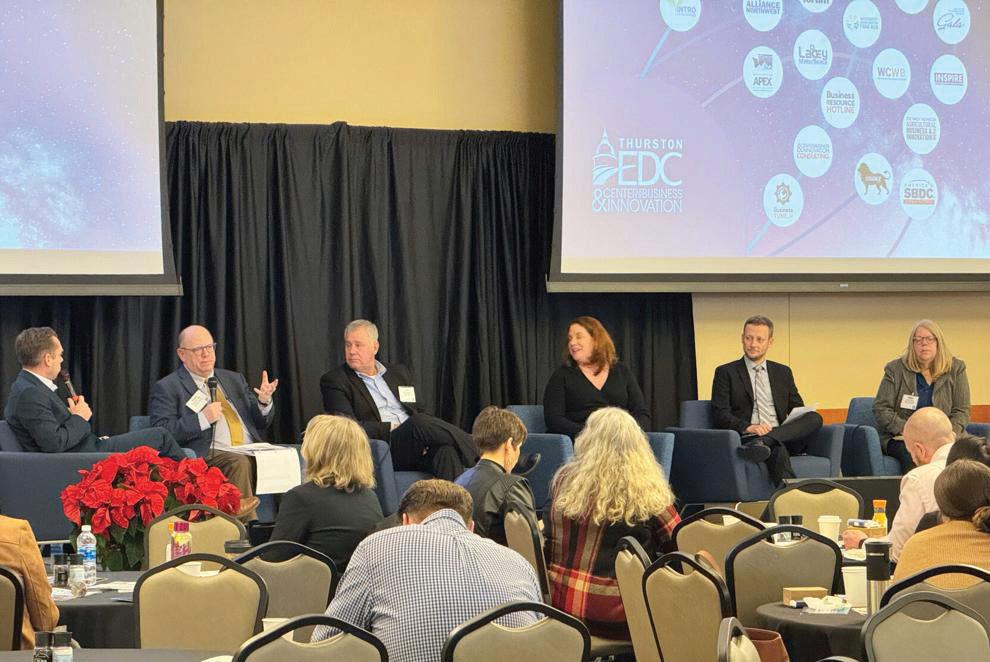
Photo by Joanna Kresge
An Economic Development Leaders Panel during the 2023 Regional Economic Forecast & Innovation Expo held on Dec. 7 at the Great Wolf Lodge in Grand Mound, including the Economic Alliance of Lewis County Executive Director Richard DeBolt, third from left.
The five-county Western Washington region encompassing Thurston, Lewis, Mason, Grays Harbor and Pacific counties gathered Dec. 7 for the 2023 Regional Economic Forecast & Innovation Expo hosted by the Thurston Economic Development Council at Great Wolf Lodge in Grand Mound.
The daylong event featured the economic development organizations of each of the five counties and highlighted the economic impact of local tribal nations, forecasted regional trends and emerging trends.
After an opening blessing from the Chehalis Tribe, the day began with the Five-County Tribal Nations Economic Impact Presentations.
Speakers included Harry Pickernell of Chehalis Tribal Enterprises, Tony Enzler of Quinault Nation Enterprises, David Burnett of Squaxin Island Enterprises, Jesse Downs of Willapa Bay Enterprises and Bob Iyall of Medicine Creek Enterprise Corp.
Each presenter touted the historical impacts of their respective tribal enterprises as well as future innovations. Pickernell — whose Chehalis Tribal Enterprises opened Great Wolf Lodge in 2008 — began by speaking about the impetus for the tribe’s End of the Trail convenience stores beginning in the 1980s.
“End of the Trail convenience stores started as a training project for tribal members interested in construction,” he said. “They were hired right out of high school and built that thing from the ground up. It had WIC foods, drinks — anything we might need out on the reservation.”
Today, Chehalis Tribal Enterprises provides many of the land leases along the Interstate 5 corridor in that area, as well as a construction company, a brewery/distillery, restaurants, a golf course, a blueberry farm, and more. Its Lucky Eagle Casino — which recently launched a new Sportsbook betting service — is what “makes all other business endeavors possible,” according to Pickernell.
Looking toward the future, Pickernell said that in addition to adding more jobs and services to the area, the tribe is endeavoring to add more charging stations for EVs along the Interstate 5 corridor to fill charging gaps. Other tribal enterprises mentioned renovations to dated hotel rooms and the addition of medical services buildings to address health care deserts and drug addiction as current and upcoming projects.
Taking the podium last out of the five tribal presenters, Iyall thanked the organizers of the event for hosting the session before addressing the crowd.
“This is a great opportunity for us to share with you,” he said. “Hopefully you guys gained some information and education and come to a realization that tribal enterprises are for real; they are viable and they’re here to serve all of us.”
Leaders Panel
An Economic Development Leaders Panel followed the tribal presentations and consisted of Lynnette Buffington of Greater Grays Harbor Inc., Joe Schmit of Economic Development Council of Mason County, Richard DeBolt of Economic Alliance of Lewis County and Susan Yirku of the Pacific County Economic Development Council.
The overall theme of the discussion was centered around the word “relief” following the COVID-19 pandemic, according to moderator Jeff Slakey of Tracing the Fjord.
For Buffington, the pandemic shone light on economic issues in her community that she could help relieve that had previously gone unnoticed.
“I think one of the things is all of us were very much the distributor of the COVID relief dollars, and they were very reactive and at some points I practically called us just an ATM for a good year and a half,” she said of the height of the pandemic. “But what we all learned in our roles was when we saw these opportunities for economic relief and we recognized financial literacy wasn’t universal across all our small businesses.”
As a result, Buffington said some relief dollars provided bookkeeping education to students in her community.
Other topics discussed during the panel included rural construction in Shelton and the larger Mason County area, fiber optic infrastructure in the coastal areas, an ongoing hydrogen project in Lewis County and beyond that is helping to create hydrogen semi-trucks, a fully funded flood levy in Grays Harbor that will spur jobs, and a recent ribbon cutting for a childcare facility in Grays Harbor.
The schedule also contained two 50-minute-long breakout sessions straddling the lunch hour, each time frame offering attendees four options to choose from in conference rooms scattered throughout the lodge.
The breakout subjects were varied and included titles like “Journey2Jobs: Connecting Workforce Development & Homeless Response,” “Building the Region’s Talent Pipeline,” “Infrastructure, Tomorrow … Today,” and “Using AI Tools for Economic Development.”
At the “Growing the Creative Sector in the Pac-5 Region” session, for example, Annette Roth, community development manager at the Washington State Arts Commission, outlined current Pac-5 activities and dove into how creatives in other regions have used the arts to diversify their respective economies.
“It’s important for us to realize that whether or not you recognize it, you interact with arts and culture every single day of your life probably dozens of times,” Roth said, noting that the creative sector in Washington state is extremely robust and that there’s more money being exchanged proportionally for artists and creatives in Washington than in New York or California.
“We’ve seen 12% growth in the past five or six years — and that’s even with the pandemic losses. You know, there was just a 1.8% decline in 2020. But what’s interesting is that earnings are up. … So, the amount of money people made per job was up during 2020, even though there were fewer employed employees in the sector,” she added.
After dispensing with the statistics, Roth went on to talk about how businesses, chambers of commerce, and cities can, through the Washington Arts Commission, obtain a creative district designation. In Thurston County, Olympia and Tenino have such designations, Roth said, with many other cities across the region in the application or review process.
Keynote
Following morning breakouts, the afternoon keynote was delivered by Hart Hodges, associate professor at Western Washington University’s College of Business Economics and James McCafferty, director of the same. The two are known for publishing quarterly reports and podcasts under the moniker Puget Sound Economic Forecaster along with other local economists.
As the few hundred event attendees were eating lunch, Hodges and McCafferty spoke on the national and regional economic trends and outlook.
“What has happened with shoplifting over the past, say, four or five years?” Hodges asked the crowd before diving into the presentation. “It’s down,” he revealed after some audience participation. “When you see data (like this), don’t just say, ‘I like it,’ ‘I don’t like it,’ ‘I agree with it’ or not — look at it. Think about it; try to figure out what it’s really saying.”
In actuality, the stats given by the duo represent the entire United States divorced from New York. When the more crime-heavy Empire State is added in, the stats change dramatically.
“So, perception becomes really important to think about as you’re thinking about something simple, like shoplifting,” Hodges continued, noting that the following facts and figures should be examined critically.
The duo spent close to 20 minutes discussing the hallmarks of what a recession looks like and when it is supposed to hit. Hodges said that in 2022, a recession was forecasted for 2023, but “the date keeps getting pushed.” The market is supposed to be softening, but consumer spending remains high.
“One of the things is really important: A lot of the data that we get — who’s working, who’s working how many hours, who is working from home, who’s hired — all come from surveys, business surveys, household surveys,” Hodges said, noting that up until 2019, survey response rates hovered between 60-70%.
“One of the things that’s happened with COVID that is problematic is that the response rates for those surveys have dropped, in some cases plummeted,” Hodges continued.
“Which makes the data really suspect,” McCafferty added.
With an abundance of caution, Hodges and McCafferty forecasted that inflation is expected to keep falling, getting close to the fed target of 2-2.5% by the end of 2024. The duo said a recession could be on the way, certainly the economy will be “much, much slower.”
As far as jobs, the duo noted an uptick in the higher-wage category of professional technical services in the region, which they said was “quite positive.” In real estate, homeowners took advantage of the lower interest rates in 2021 by refinancing at a historically low rate before the Fed increased rates in 2022.
“In other words, homeowners proved to be fairly smart. They said, ‘I like interest rates, mortgage rates around 3%, I’m going to refinance,’” Hodges said. “So now, the Federal Reserve’s raising rates trying to slow down the economy, and homeowners are saying ‘I don’t care.’”
Most of the mortgages are held by people in their 40s and early 50s, and Hodges said that projections show those homes will not go back on the market, likely becoming rental properties.
Higher interest rates are affecting the commercial real estate market, too, but Hodges said he doesn’t expect “any kind of major catastrophe” in that sector.
“During 2022 and the first part of 2023, the higher rates were not causing the problems you might have expected,” he said. “And the survey response was saying, if rates stay higher for long enough, and we get all the way up to the middle of 2024, we’re gonna have problems.”
McCafferty added: “The great part is that banks are somewhat negotiable when it comes to rates and they don’t really want the buildings, so what we’re seeing and expect to see more of is very individualistically based rates for these commercial properties.”
During downtimes throughout the day, those present were encouraged to visit the booths of the more than 30 on-site vendors, several of which offered food and beverage tastings to conclude the event.
Business as Usual, or Recession?
Lewis County Looks to Add Jobs in the Coming Years, and With Those Will Come the Need to Build a Strong and Vibrant Economy
By Luke Moerke
Chair – Economic Alliance of Lewis County

Luke Moerke
Chair - Economic Alliance of Lewis County
Well, it’s only four days till Christmas as I write this, and it will have happened by the time you read this. Most retail stores are in full swing with bustling crowds moving in and out of shopping areas.
For my business, this is traditionally a time of slowing. This has not been realized in several past years, but this year the increase in mortgage rates has really put a halt to single family residential planning, and I’ve felt that.
It is nice to have a slower pace for a change, but when that slowness starts to look like the edge of a cliff, that can be concerning. I’m not falling off any cliffs yet, but the trends are of some concern.
But, when one sector falls flat on its face there is usually another sector that picks up, and I’m starting to see some of that now. As single family residential slows to a crawl in my drafting/engineering world, there are commercial and multifamily jobs taking some of those places. Time will tell if trends continue downward, but there is reason to believe we aren’t approaching any cliffs yet.
In July the Economic Alliance had Matthew Gardner, a regional real estate expert from Windermere, down from Seattle for a Realtor’s forum where he waxed eloquently about where Lewis County sits with regard to the rest of the state and the nation (“Real Estate Economist Highlights Lewis County Infrastructure and Real Estate Seminar,” The Economic Report, July 2023).
Boiling things extremely down, things have not been “normal” for some time due to “near zero” federal rates on mortgages. It is still very likely that we experience a recession, which is defined by two consecutive quarters of negative growth, but whether that occurs early in 2024, or later, is yet to be seen.
Gardner noted that if it does happen, it will likely be a blip on the radar and not some large event. This is based on many factors, but there is some consensus in this thinking.
More recently at the Regional Economic Forecast & Innovation EXPO on Dec. 7, promoted by the Thurston Economic Development Council, keynote speakers Hart Hodges and James McCafferty from Western Washington University spent some time talking about the economy. Hart and James are well known in the field of economics, and they had similar things to say as Gardner did a few months earlier.
Hart and James don’t anticipate there that the nation’s past fiscal policies were clear predictors of what we are seeing now. They also pointed out that real inflation numbers compared to perceived inflation are not as high as people think. That was interesting to me, as it does seem that there are a lot of products that cost a lot more these days.
However, I don’t have records on the cost of a box of screws from the hardware store for the last five years. I know it’s more expensive though! Also, gas and diesel affect so much more of our other products and services, and those prices have shot up here in Washington, so I would presume that we are experiencing higher costs in our region for everything.
I’m not sure if some of these economists have a way to factor that in, but when a product or service cost is only up 3%-5% when measured annually, but the fuel surcharge that was slipped in due to the high cost of fuels wasn’t counted, it may mean our perceptions are more accurate than the “reality.”
I am still optimistic about the opportunities in our area. For one, there are multiple businesses planning on setting up in Lewis County right now, including WinCo and Fortescue to name a couple.
I’m hopeful that the Centralia Station project gets WinCo on the ground soon and that area can fill in with other businesses as needed. And, although there are varied opinions about Fortescue, we should be encouraged by this prospect, and with the potential to see the dominoes fall with other like-minded businesses after Fortescue sets foot.
I’ve said it before, and it’s worth repeating, our area looks to add more and more jobs in the coming years, and with those will come more needs that help build a strong and vibrant economy. The result will be economic boosters such as housing, education, workforce training and consumer spending.
I remain optimistic, and yet am not about to count my chickens before the eggs are hatched. Time will tell what is in store. If you’ve read this far, I encourage you to think on these things with me and try to remain positive.
Help your neighbor where you can, do good to others around you, and do what you can to better your community. I pray you all have a Merry Christmas, and a blessed New Year.
•••
Luke Moerke owns Exodus Engineering, Inc., and is chair of the Economic Alliance of Lewis County
Thurston-Lewis-Mason Central Labor Council
Resolution In Opposition To The Kroger-Albertsons Merger
WHERAS, in October of 2022, Kroger and Albertsons announced they would pursue a $24.6 billion mega-merger, joining together the two largest standalone U.S. grocery chains, and WHEREAS, as sales soared during the COVID-19 pandemic, Kroger and Albertsons investors prioritized cash profits for themselves over working families. Sales at Kroger have grown nearly 20% and sales at Albertsons nearly 23% over the past two and a half years, and WHEREAS, grocery and retail workers have suffered mental and physical duress during the pandemic and were on the front line with other essential workers as deemed by the Governor and WHEREAS, United Food and Commercial Workers represents Kroger and Albertsons workers across Washington State and bargains with both these employers, and WHEREAS, Kroger and Albertsons consistently fight against the wage increases and working conditions union members need to make their jobs livable, and WHEREAS, the mega-merger is currently undergoing antitrust review by the Federal Trade Commission and has faced scrutiny from state attorney generals across the country, and WHEREAS, Kroger and Albertsons dominate the industry, there would be far less competition if the two companies merged. Both chains have stores and manufacturing facilities in nearly every state and employ over 700,000 workers across their numerous local banners, distribution facilities and private label brands, and WHEREAS, the merger would hurt grocery workers. Evidence from researchers at Columbia University and the University of Chicago found that in many parts of the country larger employers dominate parts of the labor market and they use this market power to lower wages, and WHEREAS, food deserts and high food prices already harm our communities, and this merger would only make it worse. In 2012, the Federal Trade Commission found that mergers like this one tend to lead to price increases for consumers. Past grocery mergers have created and exacerbated food deserts, and WHEREAS, Albertsons executives stand to gain huge amounts of cash, while consumers and workers face the consequences. Already, Albertsons’ private equity owners pulled out billions in cash for themselves instead of investing in employee wages and benefits. If the merger is approved, Albertsons CEO, Vivek Sankaran, will get over $43 million, the equivalent an average Albertsons employee working 1,355 years would earn, and WHEREAS, a coalition of over 100 organizations has written numerous letters to the FTC and state Attorneys General, held meetings with federal and state elected officials and regulators, and hosted community events to oppose the merger, and WHEREAS, working people, community members and consumers in the Pacific Northwest and across the country will be hurt by the approval of this merger if wages and food access goes down and food prices go up. NOW THEREFORE, BE IT RESOLVED, that Thurston Lewis Mason Central Labor Council opposes any mega-merger that contributes to job loss, higher prices for consumers, and creation of food deserts, and BE IT FURTHER RESOLVED, that Thurston Lewis Mason Central Labor Council will join in any local actions to express our concerns for workers and our communities, and BE IT FINALLY RESOLVED, that Thurston Lewis Mason Central Labor Council will support and defend legislation that supports union job and benefit retention in the event of a mega-merger and encourage other affiliates to do the same.
Alliance
Joins In Lewis County Business Week
Economic Alliance of Lewis County
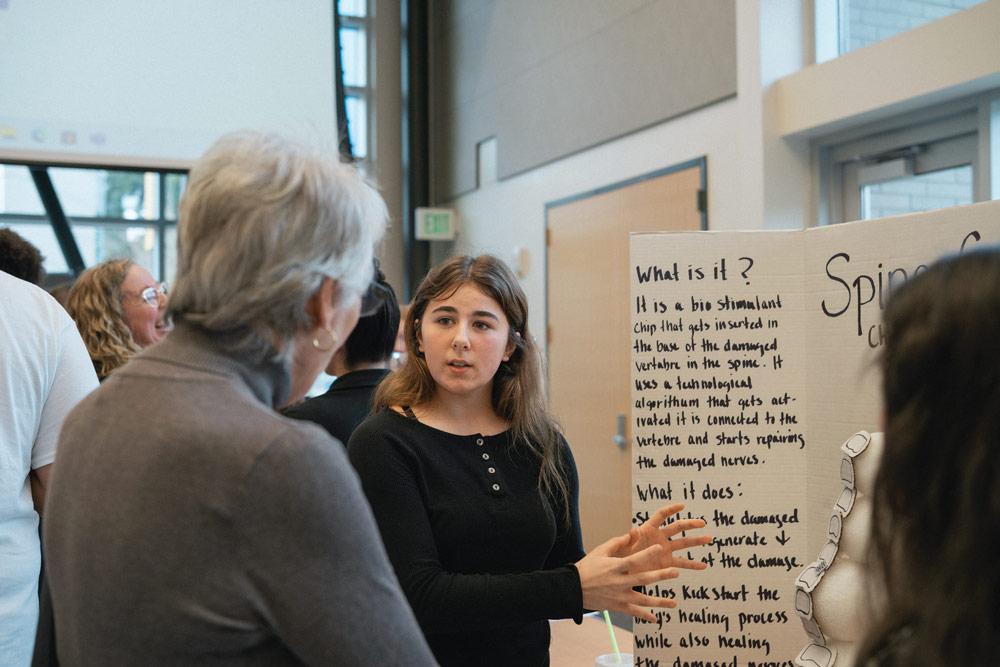
Photo by Dolly Tardiff
The Economic Alliance of Lewis County was proud to take part in Lewis County Business Week this mid-November, sending staff to interact with students from Centrala and W.F. West high schools. Held at Centralia College, it was the first Business Week in five years to join the two often-rival schools. On a Thursday morning, potential “investors” (adult volunteers) and “businesses” (groups of students) filled the TransAlta Commons, sharing pitches and trading Monopoly money as companies vied for the “fattest stack” of cash. The annual statewide event joins high school juniors from participating schools for local chapters of a hands-on marketplace simulation. Throughout the week, teams assign students to positions, including CEO, head of sales and marketing director. Students invent a company and a product, making adjustments to quality, quantity and price over six fiscal quarters.
Bishop Road Industrial Site
Economic Alliance of Lewis County
Very well-established and profitable breakfast and lunch diner and gift shop waiting for new owners to take over and operate to its full potential. Many regular and repeat customers frequent these doors daily. Been in business 48 years and the current owner has owned it for the last 17 years. Currently open Monday through Friday for breakfast and lunch only, so there is room to grow. Pre-Covid, the business was successful with prime rib nights on Fridays and Saturdays. Finished office space upstairs has a full bath and grants the opportunity for further income. Area in back is for private parties. Current owner offers to stay and train new owners. Located in the heart of downtown Chehalis, on busy Market Boulevard, the perfect stop when driving along Interstate 5 and is a favorite of locals. Business and building included in sale. This brick building was built in 1918.
Listed by CENTURY 21 Lund, Realtors
For information on this property and others available throughout Lewis County (or to list your industrial/commercial property for sale), contact Economic Alliance of Lewis County External Relations Manager
Eric Sonnenberg at [email protected] or 208-206-5407.

Eric Sonnenberg
Economic Alliance of Lewis County External Relations Manager

